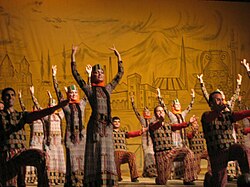
| Part of a series on the |
| Culture of Armenia |
|---|
 |
| History |
| People |
| Languages |
| Mythology |
| Cuisine |
| Part of a series on |
| Armenians |
|---|
 |
| Armenian culture |
| By country or region |
Armenian diaspora Russia |
| Subgroups |
| Religion |
| Languages and dialects |
|
| Persecution |
The Armenian dance (Armenian: Հայկական պար) heritage has been considered the oldest and most varied in its respective region. From the fifth to the third millennia B.C., in the higher regions of Armenia, the land of Ararat, there are rock paintings of scenes of country dancing. These dances were most likely accompanied by certain kinds of songs or musical instruments. In the fifth century, Moses of Khoren (Movsés Khorenats'i) himself had heard of how the old descendants of Aram (that is Armenians) make mention of these things (epic tales) in the ballads for the lyre and their songs and dances.
Traditional dancing is still popular among expatriate Armenians, and has also been very successfully exported to international folk dance groups and circle dance groups all over the world. All dancers wear the traditional costume to embody the history of their culture and to tell their ancestors stories. The design of these costumes are influenced by many factors, such as religious traditions, family methods, and practicality. The traditional coloring and exquisite beading of the costumes tie the dance and the tradition together. The beautiful movements of the Armenian cultural dance are adored by audiences around the world.[1]


